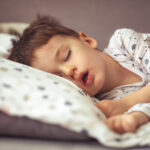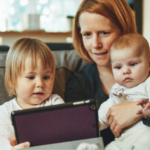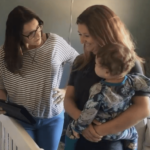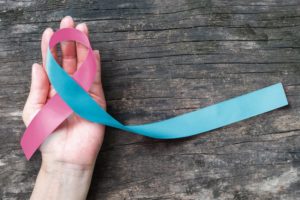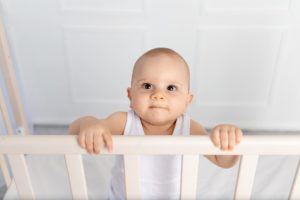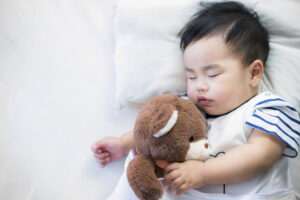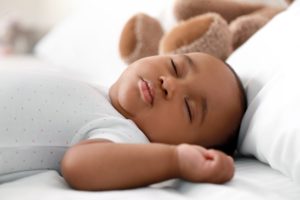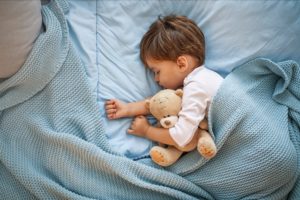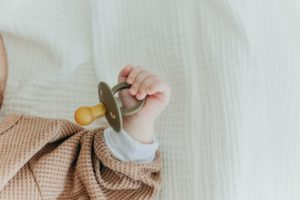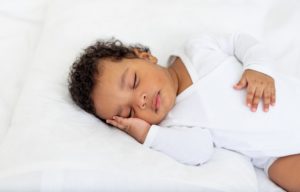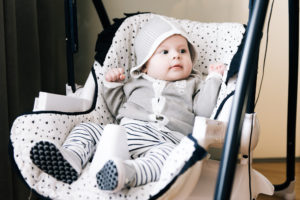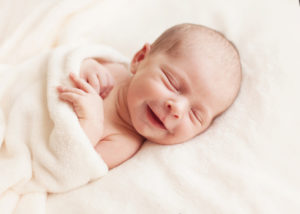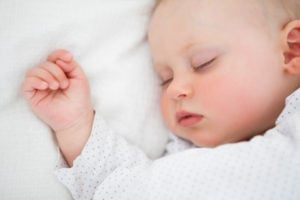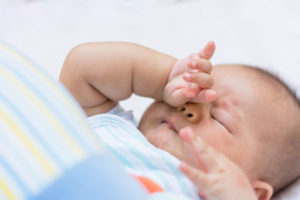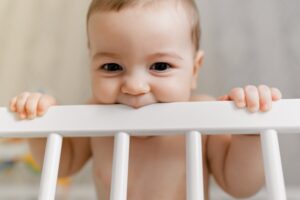When you buy through our links, we may earn a commission. Products or services may be offered by an affiliated entity. Learn more.
Why Your Baby Won’t Sleep in the Crib
The safest places for babies to sleep are cribs, bassinets, and bedside sleepers that are designed for infant sleep and meet federal safety standards. However, some babies have difficulty falling asleep in cribs or wake frequently during the night. Researchers estimate that between one-quarter to one-half of babies still wake up during the night past 6 months of age.
Babies can have difficulty sleeping in a crib for a variety of reasons. For example, teething, illness, being overtired, or not being developmentally ready to make the transition to a crib can pose challenges.
While each baby is unique, most will settle into healthy sleep patterns on their own over time. Still, parents and caregivers can try evidence-based tips to help their babies sleep more easily in their cribs.
Why Doesn’t Your Baby Like the Crib?
How often a baby wakes up in their crib can depend on their age . Premature babies and those who spend time in the neonatal intensive care unit (NICU) need support when transitioning to a new sleep environment when they come home from the hospital. These newborns may need additional time and help from their parents or caregivers to get used to sleeping in cribs.
A baby’s sleep cycle is very different from an adult’s. While newborns spend most of their days asleep, their sleep is broken up into short periods every few hours throughout the night and day. This means that it is normal for newborns to wake up every hour or so in their crib, as this is a natural part of a newborn’s sleep patterns.
There is no one right way for a baby to sleep. Babies’ sleep patterns vary widely, particularly in their first four months of life . As they develop, some healthy children may sleep up to two hours more or less than the amount of sleep that is needed based on their ages. Although sleeping a bit more or less than expected may be normal, caregivers should talk to their pediatrician if a child is not napping and sleeping in their crib close to what is appropriate for their age.
Help Your Baby Sleep Better With Pediatric Sleep Coaching
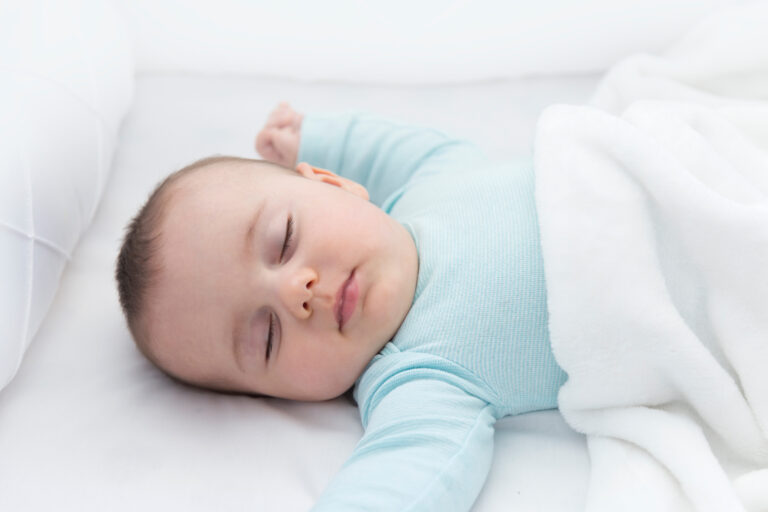
our partner at sleepdoctor.com
Learn More“Life-changing! My anxiety about my son’s sleeping habits were immediately reduced after talking to Sara. She went above and beyond to tailor a schedule to our goals, answer our questions, keep us on track, and check in to encourage us when we just thought we couldn’t do it anymore.”
Rachael B. – Verified Customer
Reasons Your Baby Suddenly Won’t Sleep in the Crib
Sometimes, a baby who previously slept well in a crib will start to resist sleep or wake up more frequently during the night. Sleep regressions happen frequently in the first two years of life and usually only last for a short time. There are several common reasons why a baby may suddenly have difficulty sleeping in a crib.
Separation Anxiety
Most babies develop separation anxiety when they are about 8 months old. Babies this age often feel scared around strangers or in new places. They may also get upset when they are not with their parents or caregivers. Separation anxiety is a normal part of development and usually ends on its own at around 2 years of age.
Babies and toddlers with separation anxiety may have difficulty falling asleep without a parent or caregiver in the room. They also may cry if they wake up during the night and find themselves alone, particularly if a parent or caregiver was with them when they fell asleep. Several strategies can help caregivers alleviate separation anxiety in babies and promote better crib sleep, including:
- Putting your baby to bed when they are drowsy but still awake
- Following a bedtime routine
- Spending time with your baby before bedtime to help them feel secure and calm
- Leaving the room for short periods of time with reassurance that you are nearby and gradually increase the time away
- Allowing your baby to have a favorite toy or blanket in the crib if they are older than 1 year of age to provide a sense of security
Lengthy Daytime Naps
As babies grow, they need fewer naps during the daytime and are able to sleep longer at night . Long daytime naps can make it harder for babies to fall asleep at bedtime. Napping less than four hours before bedtime can also interfere with sleep.
Sometimes, babies will fall into a pattern of taking several long naps during the daytime and staying up at night. This day-night reversal is usually temporary. Keeping a quiet, calm nighttime environment and encouraging babies to be active during the day can help them return to a more usual sleep schedule.
Overstimulation
While daytime activities help reinforce a day-night schedule, babies who have too much excitement and stimulation in the evening can have a hard time falling asleep.Turning down the lights and creating a relaxing bedtime routine can help an overstimulated baby get ready for bed.
Parents and caregivers of babies and young children should avoid or limit use of electronics such as tablets, smart phones, and television. Exposure to blue light from electronic screens within 30 minutes before bedtime can make it difficult for people of all ages to fall asleep. In addition, the American Academy of Pediatrics recommends that babies less than 18 to 24 months should avoid electronic screens aside from video messaging.
Teething
Babies’ first teeth usually come in at around 6 months of age. Their remaining first teeth will come in every few weeks to months until they are around 2 to 3 years old. Babies who are teething may have difficulty sleeping, be fussy, drool a lot, bite more than usual, or refuse to eat.
Chewable objects designed for teething babies, soft foods such as applesauce, or gentle gum massages with a cool washcloth can soothe sore gums . However, babies should never be put to bed with toys or washcloths . Parents or caregivers can talk with their child’s doctor about whether to give their baby over-the-counter pain relievers. Experts do not recommend giving babies over-the-counter teething gels.
Illness
Babies often have a hard time sleeping when they are sick. Pain, coughing, itching, or other symptoms can interfere with sleep . Some chronic illnesses such as gastroesophageal reflux disease, asthma, eczema, and diabetes can also cause sleep difficulties, as can some medications. Babies will usually return to their normal sleep after they recover from a short-term illness.
It is important to minimize changes in bedtime routines and avoid forming any new problems with falling asleep or getting back to sleep during a period of illness. Parents or caregivers should talk to their child’s doctor if sleeping problems continue.
Tips to Help Your Baby to Sleep in the Crib
Sleep is important for a baby’s developing brain and body. In addition, when a baby cannot sleep, the entire family may be affected. A parent or caregiver who is up all night with a sleepless baby may not function well at work. A sibling kept awake by a crying baby may have behavioral problems or difficulty at school.
Newborn babies usually sleep between 14 to 17 total hours a day, but only sleep for one to four hours at a time. However, newborn sleepless nights do not last forever. Most babies are able to sleep through the night by age 5 or 6 months. Parents and caregivers can follow evidence-based recommendations to teach babies healthy sleep behaviors and help them sleep more easily.
Follow Expert Safe Sleep Recommendations
Parents and caregivers of babies less than a year old should follow expert recommendations to reduce risk of sudden infant death syndrome (SIDS).
- Put babies to sleep on their backs: Babies should not be put to sleep on their stomachs or sides until they are at least 1 year old.
- Babies should sleep on firm, flat surfaces: Pillows, cushions, and soft mattresses designed for adults or older children are unsafe for babies. Tilted sleeping surfaces, such as a baby swing, can also put babies at risk.
- Keep toys, blankets, and other loose objects out of the crib: The only safe bedding for a baby less than 1 year old is a tight fitted sheet designed for a crib.
- Caregivers should share the room but not the bed: Babies who sleep in the same room as a parent or caregiver are at lower risk of SIDS. However, babies who sleep in the same bed as an adult are at higher risk of SIDS.
- Offer a pacifier at naptime and bedtime: Research has found that babies who are put to sleep with pacifiers have lower risk of SIDS, even if the pacifier falls out of their mouth while they sleep. Parents or caregivers of breastfeeding newborns should wait until their babies are consistently breastfeeding and gaining weight before starting pacifiers. Pacifiers should never be attached to babies’ clothes nor around their neck.
- Check for safety recalls: Always complete and return the warranty card that comes with any newly purchased baby products. Remember to regularly check with the Consumer Product Safety Commission for safety recalls on any items used to help your baby sleep, including, cribs, mattresses, bedside sleepers, and bassinets. A pediatrician can also offer guidance on how to check for product recalls.
Cultural practices commonly influence perspectives on baby sleep arrangements. Parents and caregivers can work with their pediatrician to help develop a safe and culturally relevant sleep plan for their baby.
Establish a Bedtime Routine
Consistently following a bedtime routine can help babies fall asleep. The bedtime routine should be relatively short and start about 30 minutes before the desired bedtime. It should include relaxing activities, such as a bath, pajamas, rocking, gentle music, or a story.
Put Babies in Their Cribs Drowsy but Awake
Babies aged 3 months and older should be put in their crib when they are sleepy but still awake. If they fall asleep while being rocked, held, or fed, they may wake up in the night and be unable to fall back to sleep unless they are comforted in the same way. Babies should fall asleep in the same location where they will wake up.
Keep Daytime Active and Nighttime Quiet
Parents and guardians can teach babies that the daytime is for play and nighttime is for sleep by changing the environment based on the time of day. While some people may be hesitant to disturb a napping baby, exposing babies to daytime sunlight and ambient noises helps them establish day-night schedules.
In contrast, keep lights dim or off and make sure their environment is quiet at night. If a baby wakes up during the night, quietly feed or change them and then return them to their crib while they are sleepy but still awake. Even if the baby is wide awake at night, do not turn on the lights, play with them, nor do other stimulating activities until morning.
Encourage Self-Soothing
Parents and caregivers can encourage babies to self-soothe with pacifiers, white noise, or night lights. Some experts recommend swaddling newborns, although swaddling should be stopped before babies start to roll. Children over 1 year of age may sleep with a favorite toy, doll, or blanket. If children are put to sleep with attachment objects, sounds, or lights, then those items should be present when they wake up.
Consider Sleep Training
If a baby continues to need help to fall asleep, then their parent or caregiver may consider trying sleep training. Methods of sleep training range from letting babies “cry it out” to waiting progressively longer times before responding to babies at night or gradually “fading out” the amount of time a parent or caregiver spends with a baby. There is no one right method for all babies. Parents and caregivers should adopt the technique that works best for their families, making sure to be patient and consistent.

Still have questions? Ask our community!
Join our Sleep Care Community — a trusted hub of sleep health professionals, product specialists, and people just like you. Whether you need expert sleep advice for your insomnia or you’re searching for the perfect mattress, we’ve got you covered. Get personalized guidance from the experts who know sleep best.
References
15 Sources
-
Tapia, I. E., & Wise, M. S. (2022, April 13). Sleep physiology in children. In R. D. Chervin (Ed.). UpToDate., Retrieved January 9, 2023, from
https://www.uptodate.com/contents/sleep-physiology-in-children -
Goodstein, M. H., Stewart, D. L., Keels, E. L., Moon, R. Y., & Committee on Fetus and Newborn, Task Force on Sudden Infant Death Syndrome (2021). Transition to a safe home sleep environment for the NICU patient. Pediatrics, 148(1), e2021052046.
https://pubmed.ncbi.nlm.nih.gov/34155135/ -
Deshpande, P., Salcedo, B., & Haq, C. (2022). Common sleep disorders in children. American Family Physician, 105(2), 168–176.
https://pubmed.ncbi.nlm.nih.gov/35166510/ -
Tapia, I. E. & Wise, M. S. (2022, May 26). Assessment of sleep disorders in children. In R. D. Chervin (Ed.). UpToDate., Retrieved January 5, 2023, from
https://www.uptodate.com/contents/assessment-of-sleep-disorders-in-children -
Consolini, D. M. (2022, November). Separation anxiety and stranger anxiety. Merck Manual Consumer Version., Retrieved January 9, 2023, from
https://www.merckmanuals.com/home/children-s-health-issues/symptoms-in-infants-and-children/separation-anxiety-and-stranger-anxiety -
Owens, J. A. (2020, August 18). Behavioral sleep problems in children. In R. D. Chervin (Ed.). UpToDate., Retrieved January 5, 2023, from
https://www.uptodate.com/contents/behavioral-sleep-problems-in-children -
Bollu, P. C., & Gurung, P. (2019, November 5). Normal sleep, sleep physiology, and sleep deprivation. Medscape., Retrieved January 9, 2022, from
https://emedicine.medscape.com/article/1188226-overview#showall -
Council on Communications and Media. (2016). Media and young minds. Pediatrics, 138(5), e20162591.
https://pubmed.ncbi.nlm.nih.gov/27940793/ -
Wright, J. T. (2022, March 29). Anatomy and development of the teeth. In A. Griffen (Ed.). UpToDate., Retrieved January 9, 2023, from
https://www.uptodate.com/contents/anatomy-and-development-of-the-teeth -
Raab, C. P. (2021, August). Teething. Merck Manual Consumer Version., Retrieved January 9, 2023, from
https://www.merckmanuals.com/home/children-s-health-issues/miscellaneous-disorders-in-infants-and-young-children/teething -
A.D.A.M. Medical Encyclopedia. (2020, October 2). Teething. MedlinePlus., Retrieved January 9, 2023, from
https://medlineplus.gov/ency/article/002045.htm -
Moon, R. Y., Carlin, R. F., Hand, I., & Task Force on Sudden Infant Death Syndrome and the Committee on Fetus and Newborn. (2022). Sleep-related infant deaths: Updated 2022 recommendations for reducing infant deaths in the sleep environment. Pediatrics, 150(1), e2022057990.
https://pubmed.ncbi.nlm.nih.gov/35726558/ -
Sheldon, S. H. (2022, April 8). Medical disorders resulting in problem sleeplessness in children. In R. D. Chervin (Ed.). UpToDate., Retrieved January 9, 2023, from
https://www.uptodate.com/contents/medical-disorders-resulting-in-problem-sleeplessness-in-children -
United States Consumer Product Safety Commission. (n.d.). Recalls., Retrieved January 18, 2023, from
https://www.cpsc.gov/Recalls -
Turner, T. L. & Palamountain, S. (2021, November 18). Infantile colic: Management and outcome. In M. M. Torchia (Ed.). UpToDate., Retrieved January 9, 2023, from
https://www.uptodate.com/contents/infantile-colic-management-and-outcome


